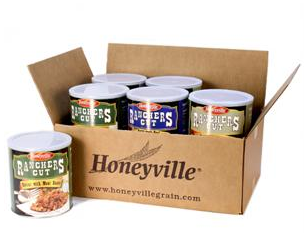The standards change for the safe accumulation of vegetables under dry conditions. This is because different vegetables have different traits, for example, tomatoes contain a huge load of water, while root vegetables, for instance, carrots and potatoes contain less. These parts, and various others, impact the proportion of time that a vegetable can be kept in dry storage, similar to the temperature expected to secure its Prepper Food .
The going with rule shows the fundamental dry amassing conditions:
- Cool and dry: onion
- Cool and moist: root vegetable, potato, cabbage
- Warm and dry: winter squash, pumpkin, sweet potatoes, dried hot peppers
Grain :
Grain, which fuses dry kitchen trimmings like flour, rice, millet, couscous, cornmeal, and so on, can be taken care of in resolutely fixed holders to hinder moistness contamination or bug or rodent attack. For kitchen use, glass holders are the most standard method. During the 20th century plastic compartments were introduced for kitchen use. They are as of now sold in a tremendous collection of sizes and plans.
Metal containers are used in the United States the tiniest practical grain accumulating uses shut top #10 metal containers. Limit in grain sacks is inadequate; shape and disturbances destroy a 25 kg material sack of grain in a year, whether or not set aside off the ground in a dry district. On the ground or spongy concrete, grain can destroy in only three days, and the grain might be dried before it will in general be handled.
Flavors and dry flavors :
Flavors and flavors are today often sold prepackaged in a way that is invaluable for washroom accumulating. The packaging has twofold inspirations driving both taking care of and allocating the flavors or flavors. They are sold in little glass or plastic compartments or resealable plastic packaging. Right when flavors or flavors are nearby or bought in mass, they can be taken care of at home in glass or plastic holders. They can be taken care of for widened periods, on occasion for a seriously long time. Regardless, following a half year to a year, flavors and flavors will one small step at a time lose their flavor as oils they contain will bit by bit disseminate during the limit.
Elective procedures for saving flavors froze for water or unsalted margarine. Flavors can be sliced and added to water on an ice block plate. In the wake of freezing, the ice strong shapes are depleted into a plastic cooler pack for taking care of in the cooler. Flavors moreover can be mixed into a bowl with unsalted margarine, then spread on wax paper and moved into a chamber shape.
Meat :

Unpreserved meat has recently had a reasonably short life away. Fleeting meats should be refrigerated, frozen, dried speedily or reestablished. Limit of new meats is an unusual request that impacts the costs, storing life and eating nature of the meat, and the legitimate strategies change with the kind of meat and the particular essentials. For example, dry developing procedures are to a great extent used to mellow epicurean meats by hanging them in meticulously controlled conditions for up to 21 days, while game animals of various sorts may be hung ensuing to shoot. Nuances depend upon singular inclinations and close-by rehearses. Current strategies of preparing meat for limit fluctuate with the kind of meat and outstanding necessities of delicacy, flavor, tidiness, and economy.

